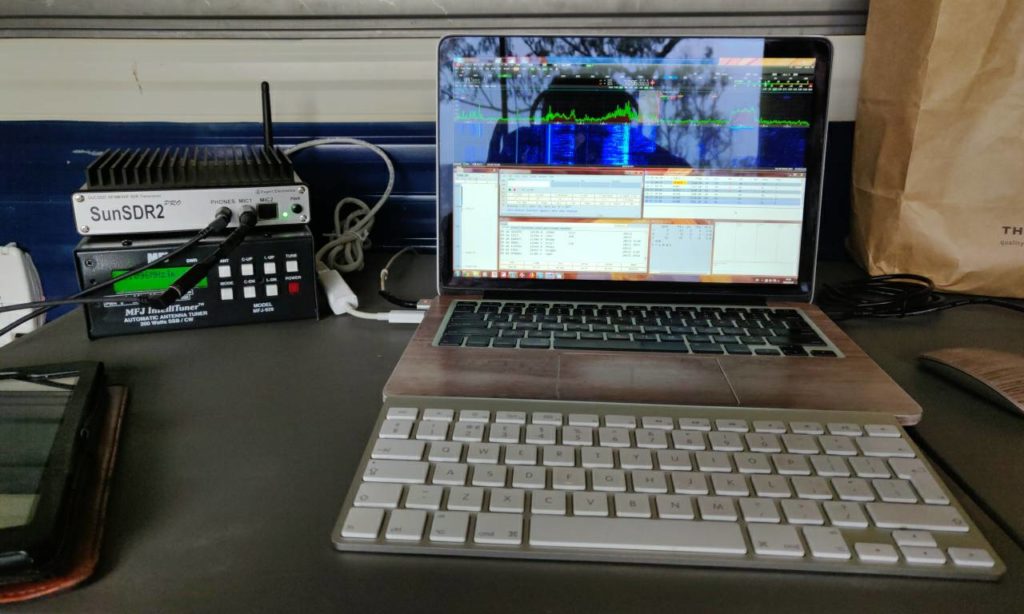27.–28.10.2018 od 00,00 do 24,00 UTC je CQWW DX CONTEST SSB. Nadväzujú sa spojenia so všetkými stanicami. Pásma: 1.8, 3.5, 7, 14, 21, 28 MHz.
Pre všetky kategórie platí, že všetky RXy aj TXy, používané súťažiacim účastníkom, musia byť umiestnené v kruhu s priemerom 500 m. Pre všetky High Power kategórie platí podmienka, že celkový výkon nesmie byť na žiadnom pásme väčší ako 1500 W, pričom výkon sa meria na výstupe PA. Všetky antény používané v konteste musia byť fyzicky káblom pripojené k vysielačom a prijímačom používaným v konteste. Nie je možné použiť rovnakú značku pre viac kategórií.
Remote (vzdialená, diaľkovo ovládaná) stanica je definovaná ako súbor vysielačov, prijímačov a antén umiestnených v kruhu s priemerom 500 m. Vzdialené prijímače mimo uvedený kruh sú zakázané. Je zakázané spotovanie vlastnej značky alebo žiadanie o spotovanie inými stanicami.
Pri použití dvoch alebo viacerých vysielačov na jednom pásme, MUSÍ byť hardvérovo zabezpečené, aby v rovnakom čase mohol byť na pásme len jeden signál. Spriahnutie dvoch alebo viacerých vysielačov do striedavého volania výzvy
je zakázané.
Tiež je zakázané robiť pokontestovéúpravy a opravy značiek v logu na základe rôznych databáz, záznamov, emailov a pod. V denníku musí byť zapísaná taká značka, akú operátor vyšle počas spojenia. Pre stanice ITU Regiónu 1 (patrí tam aj OM a OK) platí zákaz vysielania mimo povolených pásiem, to znamená v pásme 40 m nad 7200 kHz a v pásme 160 m pod 1810 kHz.
Kategórie

A. SINGLE OPERATOR – operátor vykonáva sám všetky činnosti súvisiace s prevádzkou a logovaním spojení. Operátori v kategórii SOAB môžu meniť pásma kedykoľvek. V ľubovoľnom čase je dovolený len jeden vysielaný signál.
1. SOAB (HP, LP, QRP) – je zakázené využívať DX cluster, skimmer a iné pomocné siete a technológie
2. SOSB (HP, LP, QRP) – je zakázené využívať DX cluster, skimmer a iné pomocné siete a technológie
3. SOAB Assisted (HP, LP, QRP) – je dovolené využívať DX cluster, skimmer a iné pomocné
siete a technológie
4. SOSB Assisted (HP, LP, QRP) – je dovolené využívať DX cluster, skimmer a iné pomocné
siete a technológie
B. SINGLE OPERATOR OVERLAY – každý účastník kategórie SO môže v logu vyznačiť jednu z OVERLAY kategórií. Urobí tak vložením riadku z nadpisom CATEGORY-OVERLAY do hlavičky Cabrillo logu.
1. Classic Operator (CLASSIC) – operátor používaiba jeden TCVR, nevyužíva DX cluster a podobné siete a môže v konteste pracovať max. 24 hodín. Ak má v logu zaznamenanú prevádzku dlhšiu ako 24 hodín, bude sa mu počítať len prvých 24 hodín. Použitý tcvr nesmie byť schopný počúvať počas vysielania. Stanice Assisted nebudú hodnotené v tejto
kategórii.
2. Rookie (ROOKIE) – operátor má koncesiu, od vydania ktorej neuplynuli v deň kontestu
tri roky. V denníku v kolónke SOAPBOX treba uviesť dátum vydania prvej koncesie.
C. MULTI OPERATOR (len všetky pásma) – je dovolenévyužívať DX cluster, skimmer a iné pomocné siete a technológie. Počet operátorov nie je obmedzený. V ľubovoľnom čase je na jednom pásme dovolený len jeden vysielaný signál.
1. Single TX (HP, LP) (MULTI-ONE) – v ľubovoľnej 10-minútovej perióde je dovolené pracovať len na jednom pásme a len s jedným vysielačom (= run TX). Začiatok 10-minútového intervalu sa počíta od nadviazania prvého spojenia na príslušnom pásme. Výnimka: je dovolené urobiť spojenie na jednom ďalšom pásme, ale len v prípade, ak ide o nový násobič (= multiplier TX). Aj tu však treba dodržať 10-minútové pravidlo, t.j. že násobič na ďalšom pásme je možné urobiť až po uplynutí desiatich minút. Násobičový vysielač nemôže volať výzvu. V elektronickom denníku musí byť pri každom spojení vyznačené, ktorý TX ho robil (run alebo multiplier).
2. Two TX (MULTI-TWO): Sú dovolené max. dva vysielané signály na dvoch rôznych pásmach súčasne. Obidva vysielače môžu nadväzovať spojenia so všetkými stanicami. V denníku musí byť pri každom spojení uvedené, ktorý vysielač spojenie urobil. Každý z vysielačov má dovolených max. 8 zmien pásma v ľubovoľnej celej hodine od 00 do 59 min.
3. Multi TX (MULTI-UNLIMITED): Je dovolené pracovať súčasne na všetkých šiestich
pásmach. Na každom pásme je dovolený len jeden vysielač.
Súťažný kód
RS(T) + WAZ zóna (OM, OK = 15)
Násobiče
Zeme DXCC/WAE plus IG9/IH9 a zóny WAZ na každom pásme zvlášť. Stanice /MM sa počítajú len ako zónový násobič.

Bodovanie
spojenie s EU stanicou = 1 b.
spojenie s DX stanicou = 3 b.
spojenie s vlastnou zemou = 0 b.
Denníky
Sa posielajú vo formáte Cabrillo cez webové rozhranie na www.cqww.com/logcheck/.
Denník je možné poslať aj emailom na adresu: ssb@cqww.com (SSB časť), resp. cw@cqww.com (CW časť). V názve emailovej správy uveďte len vašu kontestovú značku. Prijatie vášho denníka server automaticky potvrdí. Papierové denníky sa posielajú na adresu: CQ WW DX Contest, P. O.Box 481, New Carlisle, OH 45344, USA. Denníky treba
poslať do piatich dní po konteste, t.j. do 2.11.2018 23,59 UTC (SSB), resp. 30.11.2018 23,59 UTC (CW).
Nahrávky
Každá stanica v kategórii SO, ktorá má ambíciu umiestniť sa v prvej päťke celkového alebo kontinentálneho poradia, musí robiť zvukový záznam z celej kontestovej prevádzky, tak ako ju počuje operátor. Vyhodnocovateľ má právo vyžiadať si nahrávku do 120 dní od deadlinu pre zaslanie denníkov.
